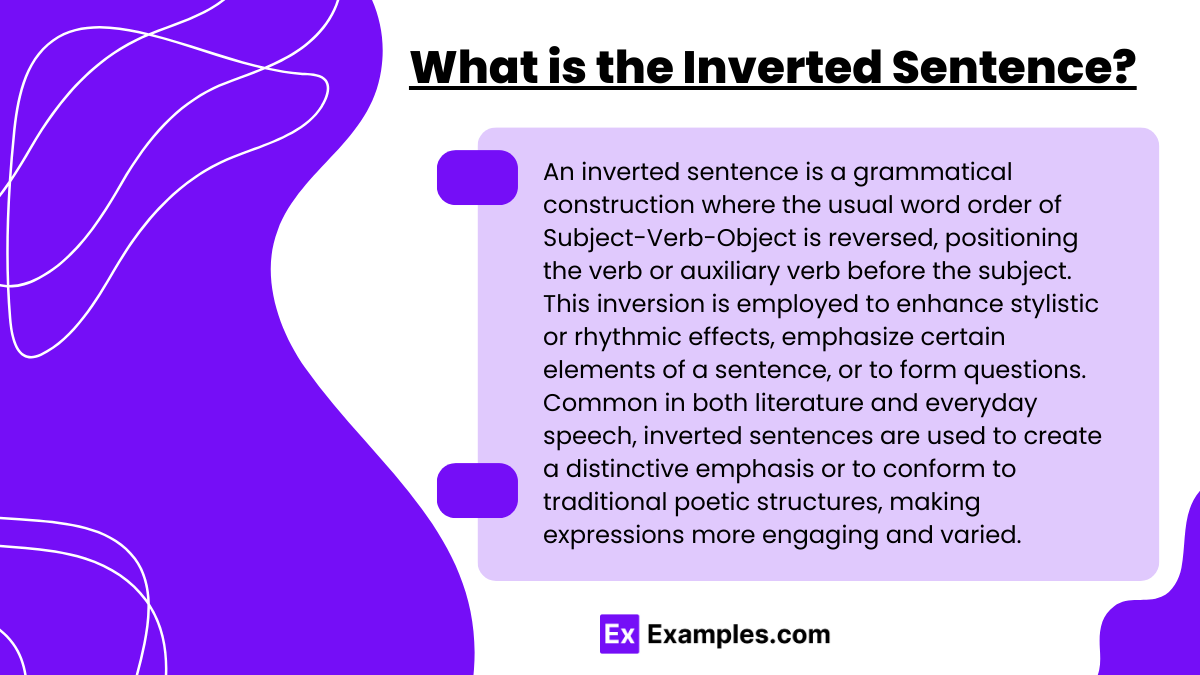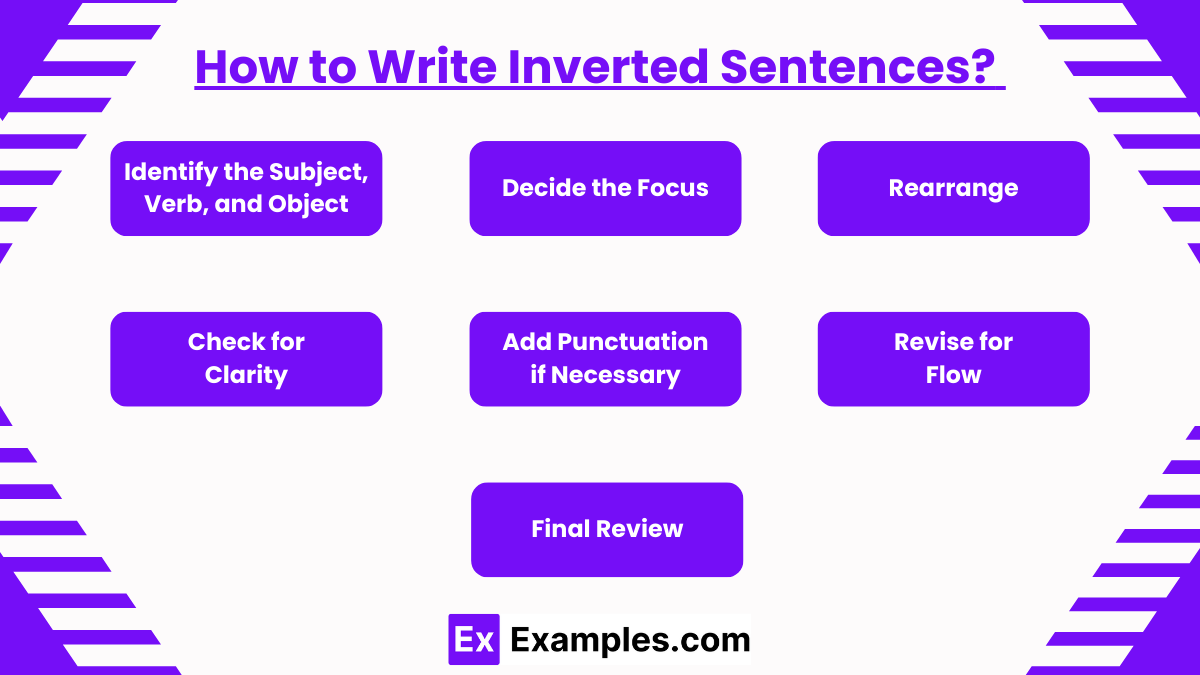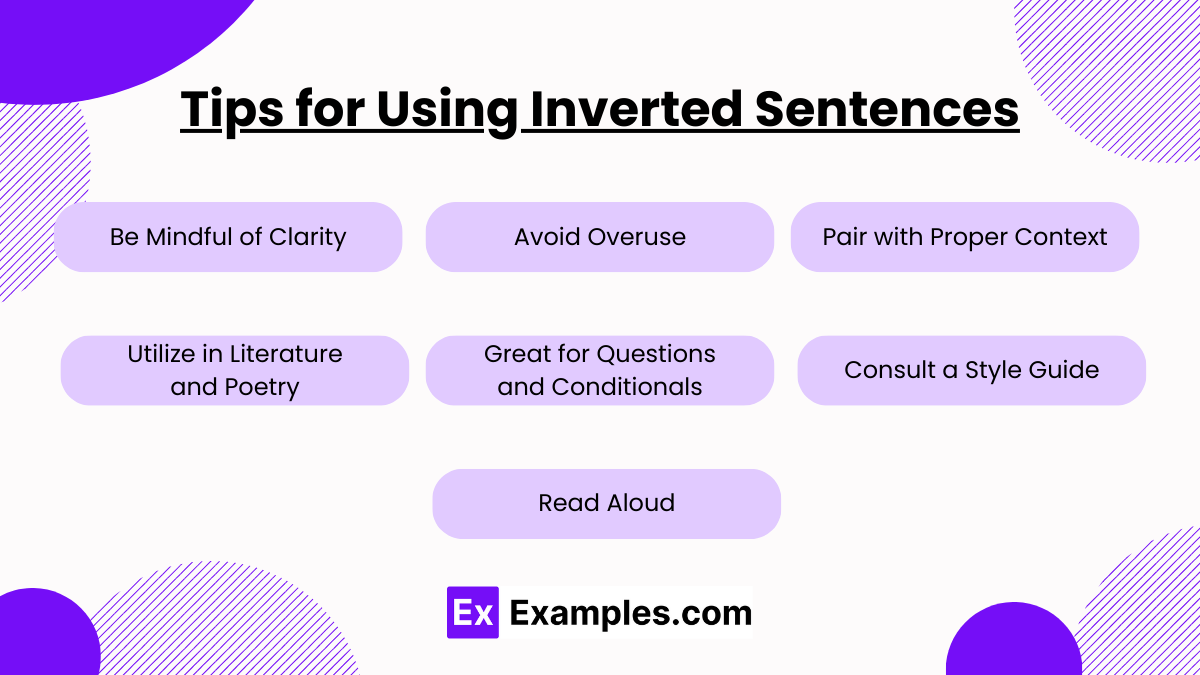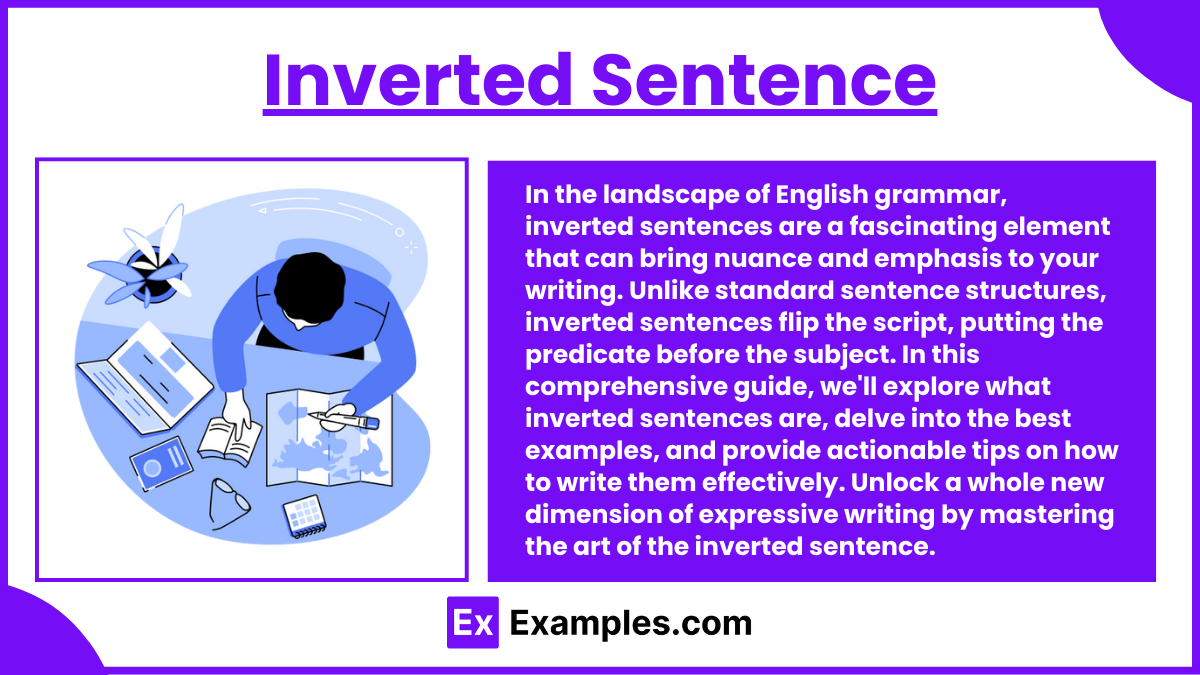99+ Inverted Sentence Examples
In the landscape of English grammar, inverted sentences are a fascinating element that can bring nuance and emphasis to your writing. Unlike standard sentence structures, inverted sentences flip the script, putting the predicate before the subject. In this comprehensive guide, we’ll explore what inverted sentences are, delve into the best examples, and provide actionable tips on how to write them effectively. Unlock a whole new dimension of expressive writing by mastering the art of the inverted sentence.
What is the Inverted Sentence?

100 Inverted Sentence Usage Examples
Inverted sentences offer an artistic touch to standard sentence structures by rearranging the typical order of subject and predicate. They are commonly used for emphasis, stylistic choices, or to conform to poetic or rhetorical guidelines. In this section, we’ve curated a list of 100 unique and distinct inverted sentence examples to serve as a comprehensive resource for understanding and using this grammatical device to its full potential.
- On the table, sits a vase of flowers.
- Into the room walked the professor.
- Above us soared the eagle.
- Around the corner came a loud shout.
- Beneath the bed hides a monster.
- Through the forest ran a deer.
- In a flash, vanished the magician.
- Over the rainbow flies a bird.
- Down the street marches a parade.
- By the window stands a lonely figure.
- Across the field galloped a horse.
- Inside the box was a ring.
- In the sky gleams the moon.
- With a smile, greeted us the host.
- Behind the curtain lurks a spy.
- Up the hill rolled a boulder.
- Against the wall leans a ladder.
- Amidst the crowd danced a jester.
- Off the cliff fell a stone.
- Before the dawn breaks the silence.
- Towards the sunset sails a ship.
- Under the bridge flows a river.
- Outside the house barked a dog.
- In the garden bloom the roses.
- Along the road wanders a nomad.
- Near the pond swims a duck.
- Among the trees whispers the wind.
- At the station waits a train.
- On the horizon appears a ship.
- By the lake sat an old man.
- Between the pages lay a secret.
- Under the blanket snuggled a cat.
- Amidst the chaos found she peace.
- After the rain comes the rainbow.
- On the wall hung a painting.
- Behind the door stood a stranger.
- Upon the shelf rests a trophy.
- In the pot boils water.
- Across the sky shoots a star.
- Down the slope slides a skier.
- Into the cave entered a bear.
- Beside the river grow wildflowers.
- With each step, creaks the floor.
- Around the bend speeds a car.
- At the market sells she fish.
- During the night howls a wolf.
- On the branch perches a bird.
- In the hallway echoes a voice.
- Through the mist emerges a figure.
- From the chimney rose smoke.
- Beside the book lies a pen.
- Under the pillow was a note.
- Above the noise heard we laughter.
- By the fence grows a rose.
- Within the walls lives a family.
- After the war came peace.
- In the pond float the lilies.
- Around the house runs a toddler.
- At the edge stands a scarecrow.
- Below the surface swims a shark.
- Behind the clouds hides the sun.
- In the song lies a message.
- Outside the class waits a student.
- On the ledge perches a dove.
- During the movie, cried the audience.
- Between the lines reads the truth.
- Against the sky silhouettes a tree.
- Across the ocean travels a message.
- With the wind moves the sail.
- In the dark glows a firefly.
- By the stove stood the cook.
- Over the hills rides a cowboy.
- Into the night fades the horizon.
- On the island waits a treasure.
- Amid the leaves rustles a squirrel.
- At the dock fishes an angler.
- Among the rocks hides a crab.
- Behind the glass swims a goldfish.
- Within the castle sleeps a princess.
- Down the river floats a canoe.
- Towards the moon climbs the rocket.
- Under the hat smiles a face.
- Above the fireplace hangs a clock.
- At the bottom lies the answer.
- Within the words finds one wisdom.
- Through the door walked she slowly.
- In the mud splashes a pig.
- Along the path skips a child.
- Across the field flies a kite.
- Under the moon dances a couple.
- On the stage performs a magician.
- At the corner stops a bus.
- Beside the hearth sits a dog.
- Within the bottle floats a message.
- Through the corridor echoes music.
- In the cage chirps a parakeet.
- Upon the water floats a leaf.
- Down the chimney comes Santa.
- Into the light steps a hero.
- On the menu is a special dish.
Inverted Sentence Exercises for Grade 3
Grade 3 students can benefit immensely from practicing inverted sentences. These exercises encourage language development and sentence structure understanding, essential for elementary learners. Inverted sentences can make grammar lessons engaging and foster creative thinking.
- On the table sits a cup.
- Beside the door stands a plant.
- In the box jumps a kitten.
- Under the tree lies a ball.
- On the wall hangs a picture.
- Over the hill rolls a tire.
- Under the bed hides a toy.
- Above the desk flies a paper airplane.
- In the pond swims a duck.
- Near the gate waits a dog.
Inverted Sentence Exercises for Grade 4
Enhance Grade 4 students’ sentence structure skills with advanced inverted sentence exercises. These activities not only boost grammar but also aid in better comprehension and written expression. Engage students effectively in sentence construction.
- In the basket lies some fruit.
- On the shelf rests a book.
- By the window flies a butterfly.
- Across the room walks a teacher.
- Under the rug crawls a bug.
- Through the tunnel drives a car.
- Beside the fireplace sits a cat.
- Over the ocean soars a plane.
- Along the river floats a boat.
- Near the sandbox plays a child.
Inverted Sentence Exercises for Grade 5
At the Grade 5 level, inverted sentences can prepare students for more complex grammar lessons. They offer a fresh approach to sentence construction, improving both reading and writing skills. Master the basics of sentence inversion with focused exercises.
- In the classroom sits the principal.
- Among the trees whistles the wind.
- Above the mountains rises the sun.
- On the chair rests a cushion.
- In the garden blooms a flower.
- Beside the fountain dances a peacock.
- On the stage sings a performer.
- Across the field runs an athlete.
- Below the surface dives a dolphin.
- Along the road marches a band.
Inverted Sentence Exercises for Grade 6
Advanced inverted sentence exercises for Grade 6 students focus on enhancing sentence structure for more formal writing. Learn how to create interest and emphasis in compositions while mastering the rules of sentence inversion.
- On the farm works a farmer.
- In the forest roams a deer.
- Through the clouds pierces a rainbow.
- Under the umbrella sits a couple.
- At the market bargains a shopper.
- Beside the church prays a monk.
- On the canvas appears a painting.
- Along the coast drifts a vessel.
- Through the mist appears a lighthouse.
- In the orchestra plays a violinist.
Inverted Sentence Exercises for Grade 7
For Grade 7 students, inverted sentences are instrumental in adding variety to writing and improving overall sentence construction skills. Develop the ability to write captivating sentences through strategic inversion techniques.
- In the crowd stands a celebrity.
- Over the field hovers a helicopter.
- Through the pages flips a reader.
- Above the village circles an eagle.
- Beside the river fishes an angler.
- On the runway struts a model.
- Across the campus cycles a student.
- Through the jungle slithers a snake.
- Around the stadium cheers a crowd.
- Within the cave lurks a bear.
Inverted Sentence Exercises for Grade 8
Inverted sentences can significantly enhance the linguistic skills of Grade 8 students. These exercises offer an in-depth understanding of sentence variety, syntax, and complex sentence structures. A must-have in your grammar lesson plans.
- Among the shelves wanders a librarian.
- In the pond floats a lotus.
- Under the blanket snuggles a baby.
- Beside the lake meditates a yogi.
- Through the gate enters a soldier.
- In the night howls a wolf.
- Above the horizon sets the sun.
- Beside the board writes a professor.
- In the snow frolics a puppy.
- Through the corridor echoes a voice.
Inverted Sentence Exercises for Grade 9
Grade 9 inverted sentence exercises target advanced sentence structuring, promoting a solid foundation for high-school level writing. These exercises are perfect for mastering the art of sentence inversion for complex literary works.
- In the alley lurks a mystery.
- Beyond the stars lies a universe.
- Through the fog drives a truck.
- Under the moonlight dances a fairy.
- On the field competes a team.
- In the castle dwells a king.
- Beside the waterfall sits a poet.
- On the ice skates a figure skater.
- Across the desert rides a nomad.
- Within the laboratory experiments a scientist.
Inverted Sentences in Literature
“In a hole in the ground there lived a hobbit.” – J.R.R. Tolkien, The Hobbit
- Inversion emphasizes the unexpected nature of the subject living in a hole.
“Into the valley of Death rode the six hundred.” – Alfred Lord Tennyson, The Charge of the Light Brigade
- The inversion here places emphasis on the dramatic action of riding into the valley.
“Among the rain and lights I saw the figure five in gold.” – William Carlos Williams, The Great Figure
- This inversion highlights the sudden appearance of the number amid the scene described.
“Whose woods these are I think I know.” – Robert Frost, Stopping by Woods on a Snowy Evening
- By inverting the sentence, Frost creates a reflective, contemplative tone.
“Full fathom five thy father lies.” – William Shakespeare, The Tempest
- Shakespeare uses inversion to create a rhythmic and mystical quality appropriate for the magical elements of the play.
“So dark the con of man.” – Dan Brown, The Da Vinci Code
- The inversion adds a poetic touch to the prose, highlighting the theme of deception.
“Rarely did we dwell on the dangers that were all around us.” – Maya Angelou, I Know Why the Caged Bird Sings
- Inversion is used here to stress how infrequently the dangers were considered.
“Quickly to the side of the ship he sprang, and into the brine.” – Herman Melville, Moby Dick
- Melville’s inversion emphasizes the suddenness and the action of the character’s movement.
“Gently rapping, tapping at my chamber door.” – Edgar Allan Poe, The Raven
- The inversion focuses attention on the sounds, enhancing the eerie and suspenseful mood of the poem.
“Never was there a tale of more woe than this of Juliet and her Romeo.” – William Shakespeare, Romeo and Juliet
- This famous inverted line from Shakespeare emphasizes the tragic nature of the story.
How to Write Inverted Sentences?

- Identify the Subject, Verb, and Object: In a standard sentence, identify these core components. For instance, in “The dog (subject) chased (verb) the ball (object),” these are the elements you can play around with.
- Decide the Focus: Determine what part of the sentence you want to emphasize. If it’s the object, for example, you might start the sentence with it.
- Rearrange: Move the chosen part to the beginning of the sentence. Remember, the most commonly inverted orders are VSO (Verb-Subject-Object) and OSV (Object-Subject-Verb).
- Check for Clarity: Inversions can sometimes make a sentence less clear. Read the sentence to ensure it retains its original meaning.
- Add Punctuation if Necessary: If your inverted sentence has become a question or requires additional punctuation for clarity, add it.
- Revise for Flow: Make sure the sentence fits smoothly into the context of your writing.
- Final Review: Read the sentence within the paragraph to ensure it adds emphasis, stylistic flair, or the intended nuance.
Tips for Using Inverted Sentences

- Be Mindful of Clarity: Inverted sentences can add style but can also complicate simple ideas. Make sure your sentence remains clear after inversion.
- Avoid Overuse: Inversion is a tool for emphasis and stylistic variety. Using it too often can make your writing feel cluttered or overly complicated.
- Pair with Proper Context: Ensure the inverted sentence fits well within its surrounding text. A misplaced inversion can disrupt the flow of your writing.
- Utilize in Literature and Poetry: Inverted sentences are a staple in more formal or artistic types of writing. However, they may seem out of place in more straightforward or informational pieces.
- Great for Questions and Conditionals: Remember that inverted structures are standard in questions and conditional sentences, so they can naturally fit into these contexts.
- Consult a Style Guide: When in doubt, consulting a style guide can provide more specific advice on when and how to use inverted sentences effectively.
- Read Aloud: Sometimes hearing a sentence can help you judge whether the inversion sounds natural and achieves the desired emphasis or nuance.
FAQs
What should I watch out for when using inverted sentences?
Use them sparingly to avoid confusing readers and to maintain clarity in your writing.
How does an inverted sentence affect readability?
Inversion can make sentences more challenging but adds stylistic richness that enhances meaning.
Are inverted sentences common in poetry?
In poetry, inversions help maintain rhyme schemes and enhance rhythmic qualities.
Can inverted sentences be used in everyday speech?
Yes, they’re often used in questions or for dramatic effect in everyday language.
Why do writers use inverted sentences?
Writers use inversion to emphasize important elements, create rhythm, or adhere to a formal style.



